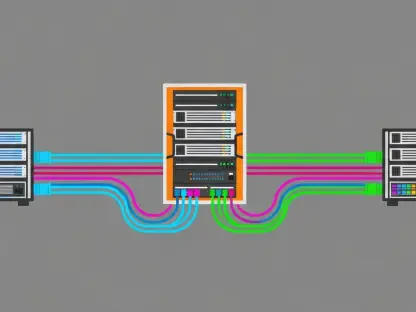The significant transformation happening in data centers worldwide due to the growing adoption of artificial intelligence (AI) is reshaping the infrastructure landscape profoundly. By driving increased investments, AI is creating new benchmarks in the industry. According to data from the Dell’Oro Group, global data center capital expenditure (CapEx) is expected to more than double, from $430 billion in 2024 to over $1.1 trillion by 2029. This transformation underscores the heightened demand for AI technology, prompting significant investments in servers, power, and cooling infrastructure to meet these new requirements.
Surge in AI-Optimized Server Spending
One of the most notable trends in this transformation is the dramatic increase in spending on servers optimized for AI workloads. Enterprises are now dedicating approximately 35% of their data center CapEx budgets to AI-accelerated servers, a significant leap from 15% in 2023. This figure is projected to rise even further, reaching about 41% by 2029, reflecting the growing importance of AI in various business operations. The shift towards AI-optimized servers is driven by the need for rapid data processing and analysis capabilities that traditional servers cannot provide.
Hyperscalers, including industry giants like Amazon, Google, Meta, and Microsoft, are at the forefront of this shift, allocating even more substantial portions of their budgets. Currently, they spend about 40% of their data center CapEx on these advanced servers. The high costs associated with AI servers, which range between $100,000 and $200,000, compared to the $7,000 to $8,000 for conventional servers, highlight the significant financial commitment required. This investment is essential for maintaining competitive advantages and capitalizing on the benefits of AI technologies.
Dominance of Major Tech Giants
Major tech companies such as Amazon, Google, Meta, and Microsoft are anticipated to account for nearly half of global data center CapEx this year. This trend indicates that AI workloads may initially remain in public clouds due to the high costs and potentially low utilization rates of AI infrastructure in private data centers. The dominance of these tech giants underscores their crucial role in driving the adoption and innovation of AI technologies within the industry. Their substantial investments are not only setting industry standards but also pushing the boundaries of what AI can achieve.
As enterprises gain a better understanding of AI workload utilization, there is potential for these workloads to migrate back on-premises. This migration would shift the dynamics of AI infrastructure, leading to more balanced and efficient use of resources across different environments. The investments made by these tech giants are setting the stage for broader adoption of AI technologies, enabling other companies to leverage these advancements more cost-effectively in their operations in the future.
Innovations in AI and Data Center Efficiency
Recent advances in AI and improvements in data center efficiency have been remarkable. Research by the Dell’Oro Group takes these developments into account, showcasing how innovative solutions are reducing operational costs and enhancing overall performance. An open-source AI model from the Chinese company DeepSeek has demonstrated that large language models (LLMs) can achieve high-quality results at lower costs by implementing intelligent changes to their operational frameworks. This breakthrough is expected to be quickly adopted by other AI companies aiming to improve cost-efficiency and performance.
Hyperscalers are also making significant strides by designing and building their chips tailored to their specific AI workloads. The market for AI accelerators is projected to reach a staggering $392 billion by 2029, with custom accelerators poised to surpass commercially available options such as GPUs. These tailor-made chips offer enhanced performance and efficiency, driving further innovation within the industry. The continuous evolution of AI technologies and data center efficiencies hints at a future where AI capabilities are more accessible and widespread.
Implications for Networking, Power, and Cooling
The deployment of dedicated AI servers necessitates significant enhancements in networking, power, and cooling infrastructures. Spending on data center physical infrastructure (DCPI) is projected to grow at a moderate pace, increasing by 14% annually to reach $61 billion by 2029. Adequate DCPI deployments are essential for supporting the extensive demands of AI workloads, ensuring efficient and reliable operation of these advanced servers. As AI adoption broadens, there will be a parallel need for robust infrastructure to handle the increased load.
Networking infrastructure, too, is seeing substantial growth due to AI’s influence. The Ethernet network adapter market, which supports back-end networks in AI compute clusters, is expected to grow at a compound annual growth rate (CAGR) of 40% by 2029. This growth reflects the heightened demand for high-speed and efficient networking solutions capable of managing the massive data transfers required by AI applications. The integration of advanced networking solutions is critical for optimizing AI performance and maintaining seamless operations in data centers.
Rising Power Demands
AI’s increasing power demands are another critical aspect of this transformation. Currently, the average rack power density in data centers stands at around 15 kilowatts per rack. However, AI workloads require significantly higher power densities, ranging between 60 and 120 kilowatts per rack. Research by IDC indicates that AI-related data center energy consumption is projected to grow annually by 45%, reaching 146 terawatt hours by 2027. This surge in energy requirements necessitates innovative approaches to power management and efficiency.
Support for these findings comes from McKinsey, which reports that power densities in data centers have doubled over the past two years and are expected to continue rising, with average densities reaching 30 kilowatts per rack by 2027. This steady increase underscores the urgent need for data centers to adopt more efficient power solutions capable of meeting the growing demands of AI workloads. Effective power management strategies will be crucial for ensuring the sustainability and reliability of data center operations in the era of AI.
Shift Towards Liquid Cooling
Traditional air-cooling systems, which have an upper limit of around 50 kilowatts per rack, are becoming inadequate for meeting the growing power demands. Consequently, there is a noticeable shift towards liquid cooling technologies in the industry. According to an IDC report, 50% of organizations with high-density racks are now employing liquid cooling as their primary method. This transition is driven by the need for more efficient cooling solutions capable of handling the higher power densities associated with AI workloads.
Additionally, 22% of all data centers have already adopted liquid cooling, with an additional 61% considering its implementation in the future. For larger data centers with capacities exceeding 20 megawatts, 38% have transitioned to direct liquid cooling solutions. These figures highlight the growing recognition of liquid cooling’s benefits in managing heat generated by high-density servers and improving overall energy efficiency. The industry is moving towards more advanced cooling methodologies to support AI’s evolving requirements.
Future-Proofing Data Centers
The rapid evolution taking place in data centers across the globe due to the increasing adoption of artificial intelligence (AI) is fundamentally transforming the infrastructure landscape. This shift is driving higher investments, setting new industry standards. Data from the Dell’Oro Group indicates that global data center capital expenditure (CapEx) is projected to more than double from $430 billion in 2024 to over $1.1 trillion by 2029. This significant transformation highlights the rising demand for AI technology, necessitating substantial investments in servers, power, and cooling systems to accommodate these advanced requirements. Moreover, the integration of AI technologies is leading to improved efficiency and performance in data centers. As AI continues to scale, the industry must adapt by enhancing current infrastructure and investing in innovations tailored for AI workloads. Consequently, this dynamic environment requires data center operators and tech companies to rethink and upgrade their strategies to stay competitive and meet the escalating demands.









